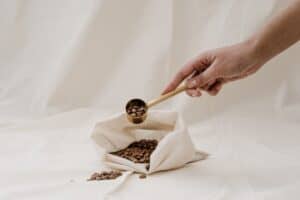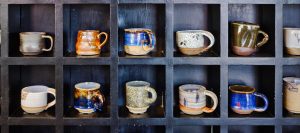Coffee has become an essential part of most people’s daily life. Getting the right amount of coffee that goes into a cup and the right coffee to water ratio can make all the difference in the quality of coffee. So, how many coffee beans are in a cup of coffee?
Contents
How Many Coffee Beans Are in a Cup of Coffee?
On average, there are about 76 coffee beans in a 12-ounce cup of coffee, 60 to 80 beans in a single shot espresso, and 140 to 180 beans in a double shot espresso. This amount of beans should provide the right strength and balance of flavors in your coffee.
The specific quantity of beans in a cup of coffee may vary based on:
- The type of coffee
- The roast level
- Grind size
- Your brewing method
- The size of your serving
You can choose to alter the number of beans you use in making a cup to achieve your desired intensity.

Factors Affecting the Number of Coffee Beans in a Cup of Coffee
A lot of factors are considered when determining the number of beans that go into a cup of coffee. A bit of math and science has been used in identifying these factors and a proper understanding of how they work will come in handy when you need to prepare your coffee.
Coffee Type
There are different types of coffee beans. This means that the general size of the beans will vary from species to species. The average coffee bean weighs between 0.004 and 0.005 ounces after being roasted. Larger species like the elephant beans can weigh as much as 0.014 ounces and smaller species can weigh much less.
Within each species, the growing conditions can also significantly influence the size, weight, and shape of the beans. This means you may have to use more or fewer beans depending on the size.
Roast Level
Another factor that affects the weight, and consequently, the quantity that goes into a cup, is the roast level of the coffee beans. The beans lose as much as 20% of their weight when roasted and will weigh less the longer they are roasted.
Roasted beans weigh about the same as when they are ground. However, they also lose a tad bit of weight as they experience moisture loss during grinding. This means that after roasting and grinding, you technically have more beans occupying less space.
Grind Size
As mentioned earlier, grinding your coffee beans also affects their weight, volume, and the quantity that eventually goes into a cup of coffee. When grinding your beans, you can choose to have a more coarse grind or a finer grind depending on your preference and probably the specifications of your coffee maker.
The smaller or finer the grind, the less space the ground coffee occupies, and the more coarse the grind, the more space the ground coffee occupies. For context, it takes more beans to get a tablespoon of finely ground coffee and fewer beans to get a tablespoon of coarsely ground coffee.
Brewing Method
Lastly, your choice of brewing method affects the number of beans in one cup of coffee. Choosing to brew your coffee using a drip coffee maker, a percolator, a French press, an espresso machine, an Aeropress, or even cold-brewing your coffee will determine the amount of coffee bean that goes into each cup.

For example, if you use an espresso machine to brew your coffee, you will have more coffee beans in a cup. This is because you usually have to use finely-ground dark roast in making espresso. In contrast, the average drip coffee maker will require a less amount of beans to produce a cup. This also varies with other brewing methods.
Related Questions
How Many Coffee Beans Make a Tablespoon of Ground Coffee?
On average, 38 coffee seeds make up a level tablespoon of ground coffee. This translates to about 0.18 ounces of ground coffee. So, you can use 2 to 2 ½ tablespoons for a 12-ounce cup of coffee.
Is a Scoop of Coffee Beans the Same as a Scoop of Ground Coffee?
No, a scoop of coffee beans is not the same as a scoop of ground coffee. However, the difference is not significant enough. The beans reduce in volume during grinding, so, a scoop of beans is just slightly different from a scoop of ground coffee. Therefore, some people may choose to regard both as the same.
Conclusion
By now you understand the various factors that affect how many coffee beans go into a cup of coffee. However, keep in mind that you will be buying your coffee by weight and not bean count. You can always use a kitchen scale to ascertain the quantity of coffee you put into your coffee.



